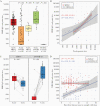Serologic and Cytokine Signatures in Children With Multisystem Inflammatory Syndrome and Coronavirus Disease 2019
- PMID: 35237703
- PMCID: PMC8883592
- DOI: 10.1093/ofid/ofac070
Serologic and Cytokine Signatures in Children With Multisystem Inflammatory Syndrome and Coronavirus Disease 2019
Abstract
Background: The serologic and cytokine responses of children hospitalized with multisystem inflammatory syndrome (MIS-C) vs coronavirus disease 2019 (COVID-19) are poorly understood.
Methods: We performed a prospective, multicenter, cross-sectional study of hospitalized children who met the Centers for Disease Control and Prevention case definition for MIS-C (n = 118), acute COVID-19 (n = 88), or contemporaneous healthy controls (n = 24). We measured severe acute respiratory syndrome coronavirus 2 (SARS-CoV-2) spike receptor-binding domain (RBD) immunoglobulin G (IgG) titers and cytokine concentrations in patients and performed multivariable analysis to determine cytokine signatures associated with MIS-C. We also measured nucleocapsid IgG and convalescent RBD IgG in subsets of patients.
Results: Children with MIS-C had significantly higher SARS-CoV-2 RBD IgG than children with acute COVID-19 (median, 2783 vs 146; P < .001), and titers correlated with nucleocapsid IgG. For patients with MIS-C, RBD IgG titers declined in convalescence (median, 2783 vs 1135; P = .010) in contrast to patients with COVID-19 (median, 146 vs 4795; P < .001). MIS-C was characterized by transient acute proinflammatory hypercytokinemia, including elevated levels of interleukin (IL) 6, IL-10, IL-17A, and interferon gamma (IFN-γ). Elevation of at least 3 of these cytokines was associated with significantly increased prevalence of prolonged hospitalization ≥8 days (prevalence ratio, 3.29 [95% CI, 1.17-9.23]).
Conclusions: MIS-C was associated with high titers of SARS-CoV-2 RBD IgG antibodies and acute hypercytokinemia with IL-6, IL-10, IL-17A, and IFN-γ.
Keywords: COVID-19; MIS-C; PIMS; SARS-CoV-2; children; cytokines; serology.
© The Author(s) 2022. Published by Oxford University Press on behalf of Infectious Diseases Society of America.
Figures



References
-
- Penner J, Abdel-Mannan O, Grant K, et al. . 6-month multidisciplinary follow-up and outcomes of patients with paediatric inflammatory multisystem syndrome (PIMS-TS) at a UK tertiary paediatric hospital: a retrospective cohort study. Lancet Child Adolesc Health 2021; 5:473–82. - PubMed
LinkOut - more resources
Full Text Sources
Miscellaneous

